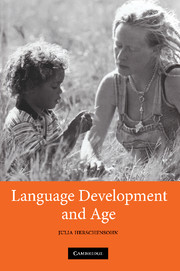Book contents
- Frontmatter
- Contents
- List of figures
- List of tables
- Preface
- Acknowledgments
- List of abbreviations
- 1 Just in time: is there a critical period for language acquisition?
- 2 Right on time: process and schedule of first language acquisition
- 3 All in good time: a window of opportunity for first language acquisition
- 4 Behind time: process and schedule of second language acquisition
- 5 Pressed for time: age constraints in second language acquisition
- 6 Biding time: further consideration of age and acquisition
- 7 It's about time: evaluation of age sensitivity in language acquisition
- Bibliography
- Index
- References
Bibliography
Published online by Cambridge University Press: 22 September 2009
- Frontmatter
- Contents
- List of figures
- List of tables
- Preface
- Acknowledgments
- List of abbreviations
- 1 Just in time: is there a critical period for language acquisition?
- 2 Right on time: process and schedule of first language acquisition
- 3 All in good time: a window of opportunity for first language acquisition
- 4 Behind time: process and schedule of second language acquisition
- 5 Pressed for time: age constraints in second language acquisition
- 6 Biding time: further consideration of age and acquisition
- 7 It's about time: evaluation of age sensitivity in language acquisition
- Bibliography
- Index
- References
- Type
- Chapter
- Information
- Language Development and Age , pp. 242 - 285Publisher: Cambridge University PressPrint publication year: 2007



